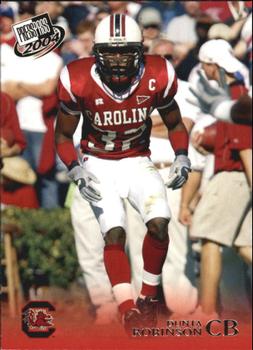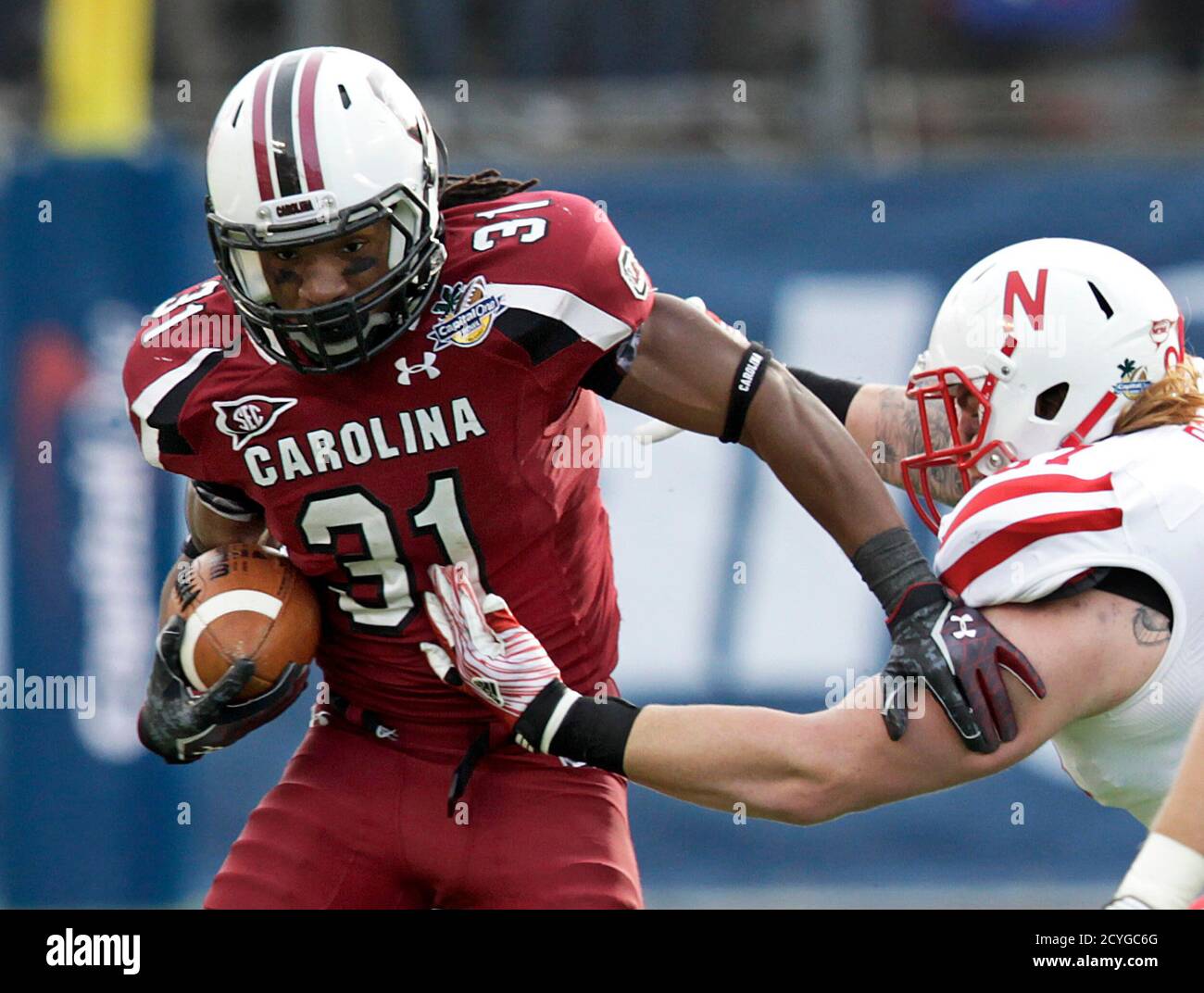Gamecock Fanatics
You are using an out of date browser. It may not display this or other websites correctly.
You should upgrade or use an alternative browser.
You should upgrade or use an alternative browser.
Countdown to Kickoff
- Thread starter Swayin
- Start date
Homebrewcock
GCF Top Poster


:format(jpeg)/cdn.vox-cdn.com/uploads/chorus_image/image/46820132/dmac_spring66.0.0.JPG)
Last edited by a moderator:
Great story! Funny that they mention her in World of Warships, where she is, sadly, a bit of a pinata.USS New Orleans, CA-32.
https://en.wikipedia.org/wiki/USS_New_Orleans_(CA-32)
Improvise, Adapt, Overcome.
Sa-lute!
I erred yesterday and in my countdown I put the tater game as the 33rd of our 33 wins in our big 3-year stretch ... but our bowl game was actually win #33, so we will do that today.
South Carolina quarterback Connor Shaw's career has been marked by a mix of special moments and others he'd like to forget.
He made sure his final game was one he'll be able to savor.
Shaw was responsible for five touchdowns, including three passing, and No. 8 South Carolina outlasted No. 19 Wisconsin 34-24 in the Capital One Bowl on Wednesday.
The Gamecocks' senior was named the game's MVP after picking apart the Badgers defense, completing 22 of 25 passes for 312 yards. Shaw also had scores rushing and receiving. South Carolina (11-2) won its third straight bowl game to cap its third straight 11-win season.
After untimely injuries and losses culminated in the Gamecocks missing a spot in the BCS, Shaw said this performance offered some redemption.
"I told the team before the game that we've faced every possible scenario we could possible face this season and that Wisconsin would be no different," Shaw said. "I'm so glad the way we battled throughout the game and our defense came and played.
"I couldn't be more proud."
/cdn.vox-cdn.com/uploads/chorus_image/image/26094829/20140101_kkt_mb2_047.0.jpg)
South Carolina quarterback Connor Shaw's career has been marked by a mix of special moments and others he'd like to forget.
He made sure his final game was one he'll be able to savor.
Shaw was responsible for five touchdowns, including three passing, and No. 8 South Carolina outlasted No. 19 Wisconsin 34-24 in the Capital One Bowl on Wednesday.
The Gamecocks' senior was named the game's MVP after picking apart the Badgers defense, completing 22 of 25 passes for 312 yards. Shaw also had scores rushing and receiving. South Carolina (11-2) won its third straight bowl game to cap its third straight 11-win season.
After untimely injuries and losses culminated in the Gamecocks missing a spot in the BCS, Shaw said this performance offered some redemption.
"I told the team before the game that we've faced every possible scenario we could possible face this season and that Wisconsin would be no different," Shaw said. "I'm so glad the way we battled throughout the game and our defense came and played.
"I couldn't be more proud."
/cdn.vox-cdn.com/uploads/chorus_image/image/26094829/20140101_kkt_mb2_047.0.jpg)
USS Monoghan, DD-32.
_at_anchor.jpg)
The new ship the Monaghan surrendered her name to was DD-354.

https://en.wikipedia.org/wiki/USS_Monaghan_(DD-354)
_at_anchor.jpg)
https://en.wikipedia.org/wiki/USS_Monaghan_(DD-32)World War I
Joining the Atlantic Fleet, Monaghan took part in fleet readiness training and operations which prepared the US Navy to enter action immediately when its country joined the Allies in World War I. Monaghan's first war service was on patrol along the Atlantic coast; she then escorted troop convoys through the dangerous mid-ocean section of their crossings. From November 1917 until the Armistice a year later, Monaghan made antisubmarine patrols against the U-boat menace in European waters. Returning from occupation duty, Monaghan decommissioned at Philadelphia on 4 November 1919.
Inter-war period
Monaghan was transferred to the Coast Guard on 7 June 1924 to serve in the Rum Patrol. She was stationed at New London, Connecticut until she was sent to Boston, Massachusetts in 1930.
She was returned to the Navy on 8 May 1931. Her name was dropped on 1 July 1933 so that it might be assigned to a new destroyer, and she was sold to Michael Flynn of Brooklyn, New York on 22 August 1934 for scrapping in accordance with the London Naval Treaty.
The new ship the Monaghan surrendered her name to was DD-354.
Monaghan was present during the Pearl Harbor raid on December 7, 1941. She participated in the Battle of the Coral Sea and the Battle of Midway in 1942. Monaghan was sunk in a typhoon east of the Philippines in 1944.
Pearl Harbor
On December 7, 1941, Monaghan was a ready duty destroyer in Pearl Harbor, and at 07:51 was ordered to join Ward, who had just sunk an unidentified submarine off the entrance to Pearl Harbor an hour earlier. Four minutes later, before Monaghan could get underway, the Japanese air attack began. Monaghan opened fire, and at 08:27 was underway to join Ward when notified of the presence of a Ko-hyoteki class midget submarine in the harbor. Monaghan headed for the trespasser and the captain, LCdr. Burford, giving the order to ram. The submarine turned and fired its torpedo at the Monaghan. It missed, passing within 50 yards of the destroyer's starboard side. The Monaghan rammed the submarine glancingly, then sank it with two depth charges. Because of the shallowness of the harbor, when the depth charges detonated, the explosions lifted the Monaghan's stern out of the water. The destroyer then went out of control and smashed into a barge.
She headed on out of the harbor to patrol offshore for the next week, then joined Lexington in the attempt to relieve Wake Island, but Wake was captured by the Japanese before Lexington's force could bring aid. Homeward bound, Monaghan, with Dale and Aylwin, made repeated attacks on an enemy submarine, causing it to broach and give off a large oil slick.
Loss in a typhoon
After training off California and Hawaii, Monaghan sailed for Ulithi 11 November. There she joined the escort for three fleet oilers bound for a rendezvous 17 December with TF 38, whose planes had been striking central Luzon in support of the Mindoro invasion. The ship was expecting to refuel and probably had reduced its ballast in order to take on fuel.
Typhoon "Cobra" hit before the Monaghan was ready to ride it out. Typhoon Cobra claimed 790 lives in the 3rd Fleet, and sank Spence, Hull, and Monaghan. Six men survived the Monaghan sinking, reportedly rescued by Brown and/or Tabberer. After drifting on a raft three days, the men reported that Monaghan took roll after roll to starboard, finally going over. The Typhoon Cobra tragedy, Admiral Chester Nimitz said, "represented a more crippling blow to the Third Fleet than it might be expected to suffer in anything less than a major action".
Monaghan received 12 battle stars for World War II service.

https://en.wikipedia.org/wiki/USS_Monaghan_(DD-354)
Last edited by a moderator:
Have you ever read "Halsey's Typhoon?" Poor Monaghan.USS Monoghan, DD-32.
https://en.wikipedia.org/wiki/USS_Monaghan_(DD-32)
The new ship the Monaghan surrendered her name to was DD-354.
https://en.wikipedia.org/wiki/USS_Monaghan_(DD-354)
That's one I haven't read, but I thought The Caine Mutiny movie covered the typhoon pretty well.Have you ever read "Halsey's Typhoon?" Poor Monaghan.
31st Division - Made up of NG soldiers from Alabama, Florida, Georgia, Louisiana, Michigan, Illinois, and Mississippi
https://en.wikipedia.org/wiki/31st_Infantry_Division_(United_States)

https://en.wikipedia.org/wiki/31st_Infantry_Division_(United_States)

Last edited by a moderator:
USS Augusta, CA-31.
_steaming_off_Portland,_Maine_(USA),_on_9_May_1945_(NH_97932).jpg)
_steaming_off_Portland,_Maine_(USA),_on_9_May_1945_(NH_97932).jpg)
https://en.wikipedia.org/wiki/USS_Augusta_(CA-31)USS Augusta (CL/CA-31) was a Northampton-class cruiser of the United States Navy, notable for service as a headquarters ship during Operation Torch, Operation Overlord, Operation Dragoon, and for her occasional use as a presidential flagship carrying both Franklin D. Roosevelt and Harry S. Truman under wartime conditions (including at the Atlantic Charter). She was named after Augusta, Georgia, and was sponsored by Miss Evelyn McDaniel of that city.
USS Mayrant, DD-31.
.jpg)
.jpg)
https://en.wikipedia.org/wiki/USS_Mayrant_(DD-31)World War I
Mayrant was recommissioned on 2 January 1918 and joined the wartime fleet in the spring. She was employed as an escort ship, operating along the coast and across the Atlantic. Following the Armistice, she cruised south for winter maneuvers and then cruised off the middle Atlantic coast until entering the Navy Yard at Charleston, South Carolina, for a second pre-inactivation overhaul on 21 June 1919. Departing Charleston on 16 July she sailed back to Philadelphia where she was decommissioned for a final time on 12 December 1919.
USS Bon Homme Richard, CV-31.
_underway_at_sea_c1965.jpg/1280px-USS_Bon_Homme_Richard_(CVA-31)_underway_at_sea_c1965.jpg)
_underway_at_sea_c1965.jpg/1280px-USS_Bon_Homme_Richard_(CVA-31)_underway_at_sea_c1965.jpg)
https://en.wikipedia.org/wiki/USS_Bon_Homme_Richard_(CV-31)USS Bon Homme Richard (CV/CVA-31) was one of 24 Essex-class aircraft carriers completed during or shortly after World War II for the United States Navy. She was the second US Navy ship to bear the name, the first one being named for John Paul Jones's famous Revolutionary War frigate by the same name. Jones had named that ship, usually rendered in more correct French as Bonhomme Richard, to honor Benjamin Franklin, the American Commissioner at Paris, whose Poor Richard's Almanac had been published in France under the title Les Maximes du Bonhomme Richard.
Bon Homme Richard was commissioned in November 1944, and served in the final campaigns of the Pacific Theater of Operations, earning one battle star. Decommissioned shortly after the end of the war, she was recommissioned in 1951 for the Korean War. In her second career she operated exclusively in the Pacific, playing a prominent role in the Korean War, for which she earned five battle stars, and the Vietnam War. She was modernized and recommissioned in 1955. She was decommissioned in 1971, and scrapped in 1992.
Last edited by a moderator:
USS Sterett, CG-31.
_underway_on_7_September_1990_(6452265).jpg/1920px-USS_Sterett_(CG-31)_underway_on_7_September_1990_(6452265).jpg)
https://en.wikipedia.org/wiki/USS_Sterett_(CG-31)
She was the third ship to be named Sterett. The previous one was DD-407, which made a name for herself during WW2.
.jpg/1280px-USS_Sterett_(DD-407).jpg)
_underway_on_7_September_1990_(6452265).jpg/1920px-USS_Sterett_(CG-31)_underway_on_7_September_1990_(6452265).jpg)
https://en.wikipedia.org/wiki/USS_Sterett_(CG-31)
She was the third ship to be named Sterett. The previous one was DD-407, which made a name for herself during WW2.
.jpg/1280px-USS_Sterett_(DD-407).jpg)
https://en.wikipedia.org/wiki/USS_Sterett_(DD-407)Naval Battle of Guadalcanal
The American warships threaded their way into the Japanese formation, and a deadly crossfire immediately engulfed the Sterett. At 01:50, Admiral Callaghan ordered odd ships in column to open fire to starboard and even ships to engage the enemy to port. the Sterett fired on a cruiser to starboard and, in turn, took a terrific pounding from the Japanese battleship Hiei on her port side.
At this point, the battle degenerated into a swirl of individual duels and passing shots. The Sterett turned now to Hiei, launching four torpedoes, and peppering her superstructure with 5-inch shells. The Sterett scored two torpedo hits (although these did not explode, not having time to arm before striking) before a third target crossed her bow. At the appearance of an enemy more her size, the Sterett tore into the destroyer with her guns and launched two torpedoes. Before the Japanese destroyer could fire a single shot at Sterett, she was lifted from the water by the exploding torpedoes and rapidly settled to the floor of "Ironbottom Sound".
By this time, the Sterett had undergone a brutal beating from Hiei and various other enemy ships. Author and torpedo commander of the USS Sterret Thomas O McWhorter wrote in the book Stand and Fight:
"The Sterett took eleven direct hits, all on her port side, all above the waterline, and sustained severe shrapnel damage from many near misses. Her after deck house and number three gun, an unshielded open mount back aft, were engulfed by flames that brightly illuminated the flag on the small ship's mainmast truck. Her after handling rooms were set afire, causing powder in the ready service storage to ignite. Twenty-eight men were dead, another thirteen seriously wounded. Four leaped overboard to extinguish their burning clothes. Those who stayed aboard and saved the ship braved burning compartments to turn flood valves and remove wounded from impossible places. They defied smoke to soak powder, grid bulkheads, patch holes, fix pumps, run hoses, and keep electricity flowing. They allowed their hands to melt while connected superheated brass hose couplings to fight fires."
At 02:30, with the Japanese retiring toward Savo Island, Sterett, her after guns and starboard torpedo tubes out of commission, began to withdraw. She had difficulty overtaking the rest of her force because of her damaged steering gear and the necessity to reduce speed periodically to control the blaze on her after deck. By dawn, she was back in formation on the starboard quarter of the San Francisco.
Last edited by a moderator:
USS Clemson, APD-31.
,_circa_in_1919.jpg)
_off_the_Charleston_Navy_Yard_on_21_April_1944.jpg/1280px-USS_Clemson_(APD-31)_off_the_Charleston_Navy_Yard_on_21_April_1944.jpg)
Clemson is not a common last name and I would not guess there was ever a family tie between SC and NJ. It makes you wonder if there is a family tie there or did someone there just buy the ship's bell because of the ship's name?
Tater Boat. LOL
,_circa_in_1919.jpg)
_off_the_Charleston_Navy_Yard_on_21_April_1944.jpg/1280px-USS_Clemson_(APD-31)_off_the_Charleston_Navy_Yard_on_21_April_1944.jpg)
https://en.wikipedia.org/wiki/USS_Clemson_(DD-186)USS Clemson (DD-186/AVP-17/AVD-4/APD-31) was the lead ship of her class of destroyers which served in the United States Navy during World War II. She was named for Midshipman Henry A. Clemson (1820–1846), who was lost at sea when the brig USS Somers capsized in a sudden squall off Vera Cruz on 8 December 1846 while chasing a blockade runner. Entering service in 1919, the ship had a brief active life before placed in reserve in 1922. Converted to an aircraft tender in 1939, the ship reactivated in 1940. In 1943, Clemson reconverted to a destroyer and served in the Battle of the Atlantic during World War II. In 1944, the ship was converted into a high speed transport and transferred to the Pacific taking part in several invasions. Following the end of the war, the ship was taken out of service again and sold for scrapping in 1946.
As of 2019, she is the only ship in the United States Navy to have received the name Clemson.
World War II
In the Atlantic
Reclassified AVP-17, 15 November 1939, and converted into a small aircraft tender, Clemson was recommissioned 12 July 1940. On 6 August, she was again reclassified, becoming AVD-4, and on 18 August reported to Commander, Aircraft, Scouting Force, Atlantic Fleet at Norfolk, Virginia. From 29 August 1940 to 28 November 1941 she tended patrol planes in the Caribbean and at the Galapagos Islands. Clemson then sailed south arriving at Recife, Brazil, 6 December. She remained on the coast of Brazil until 22 January 1942 when she returned to the Galapagos Islands. For the next year the tender shuttled between there and the Caribbean as her services was required. She returned to Norfolk, 2 March 1943 and then moved to Charleston, for reconversion to a destroyer (although not reclassified DD-186 until 1 December 1943).
On 30 May 1943, she joined the pioneer American hunter-killer group built around Bogue. Clemson made eight patrols with the group during which it sank eight German submarines, a major contribution to victory in the Battle of the Atlantic. Clemson shared in the credit for the sinking of U-172 on 13 December at 26° 19' N., 29° 58' W. After an overhaul at New York early in 1944, she escorted a convoy to Casablanca and back between 25 January and 9 March. Once more, Clemson underwent conversion, this time to a high speed transport at Charleston Navy Yard (reclassified APD-31, 7 March 1944).
Clemson shared in the Presidential Unit Citation awarded the Bogue hunter-killer group.
In the Pacific
Clearing Charleston on 1 May 1944, the transport reached Pearl Harbor on 24 May and embarked Underwater Demolition Team 6 (UDT 6). She then sailed westward to act as a mother ship for UDT 6 as it prepared beaches immediately before the invasions of Saipan, Guam, Peleliu, Leyte and of Luzon. While entering Lingayen Gulf 5 January 1945, she drove off a Japanese air attack. Clemson escorted convoys to Ulithi, Saipan, and Okinawa before returning to San Pedro, Los Angeles, 6 July. Re-designated DD-186, 17 July, she was still undergoing reconversion when World War II ended.
She was decommissioned 12 October 1945 and sold 21 November 1946. The ship's bell is privately owned in Clemson, South Carolina.
https://en.wikipedia.org/wiki/Henry_A._ClemsonHenry A. Clemson (1820 – 8 December 1846) was an officer in the United States Navy in the early 19th century.
Life
Born in New Jersey, Clemson was appointed a midshipman in 1836. He served in St. Mary's and the brig Somers during the Mexican–American War.
Passed midshipman Clemson drowned on 8 December 1846 when Somers capsized off Vera Cruz in a squall while chasing a blockade runner.
USS Clemson (DD-186) was named in his honor.
The Mexican War Midshipmen's Monument was erected at the United States Naval Academy in 1948. It is in the memory of Clemson and three other midshipmen who died at Vera Cruz. The monument was at one time known as the Clemson Monument.
Clemson is not a common last name and I would not guess there was ever a family tie between SC and NJ. It makes you wonder if there is a family tie there or did someone there just buy the ship's bell because of the ship's name?
Tater Boat. LOL
Last edited by a moderator:




_underway_in_Puget_Sound_on_30_July_1943_(NH_94847).jpg/1280px-USS_New_Orleans_(CA-32)_underway_in_Puget_Sound_on_30_July_1943_(NH_94847).jpg)
_underway_off_San_Diego,_California_(USA),_circa_in_February_1985_(6640039).jpg/1280px-USS_William_H._Standley_(CG-32)_underway_off_San_Diego,_California_(USA),_circa_in_February_1985_(6640039).jpg)





